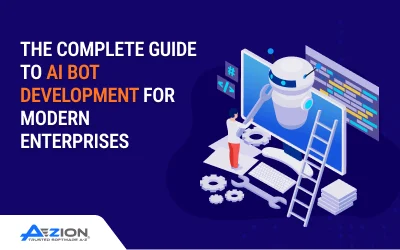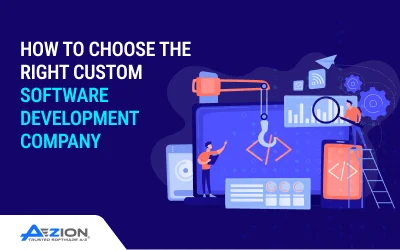The term “enterprise collaboration” seeks to encompass how employees interact with one another across the work environment, and outside of it. An enterprise collaboration Initiative can play an integral role in fostering professional relationships, teamwork, collaboration, and efficiency at scale.
If you’re looking to streamline processes and give your growing teams the tools they need to work together seamlessly, Aezion can help. Contact us today to learn how we can help you get a head start on enterprise collaboration.
What Is an Enterprise Collaboration Initiative?
On paper, enterprise collaboration looks simple. It sounds like a mere matter of giving your employees the ability to interact with one another. In practice, every organization is quick to realize that enterprise collaboration is not easy to achieve. In fact, if enterprise collaboration truly were as simple as it seems, you wouldn’t be considering an enterprise collaboration initiative.
Enterprise collaboration initiatives are necessary because, without one, you have no way to manage, measure, or improve the current state of collaboration at your company. Therefore, such an initiative plays a significant part in an Enterprise Information Management (EIM) strategy.
Some of the biggest hurdles to enterprise collaboration include email overwhelm, difficulty accessing information, lack of visibility into workload, chaotic cross-functional collaboration, and having the wrong software (or not knowing how to use it correctly).
An enterprise collaboration initiative addresses common hurdles that impede enterprise collaboration to help everyone work more efficiently—and that’s just the beginning. Upon closer inspection, you’ll note more effective knowledge capture, transfer, and sharing, along with improved business outcomes overall.
Benefits of an Enterprise Collaboration Initiative
It’s a fact: disengaged employees are actively costing your business. Gallup estimates that these people cost companies in the United States up to $550 billion annually in lost productivity. Aside from improving efficiency, an enterprise collaboration initiative will help you attract and retain top talent as the world continues shifting toward more flexible work processes.
The measurable benefits that you can expect after implementing an enterprise collaboration initiative include:
- Improved engagement during meetings and other interactions. If you use video as part of your program, you can significantly improve attendance by providing an alternative to in-person meetings.
- Consolidated costs. Cloud-based platforms often support a number of tools, and this consolidation can provide cost savings. Taking a cloud-based approach to enterprise collaboration gives your IT department unprecedented agility and cost efficiency while unlocking key tools.
- Simplified security, data management, and access. Not only will your employees have all the tools they need at their fingertips, but your business will benefit from improved visibility, security, and management thanks to the features of cloud applications.
- Increased productivity. An enterprise collaboration initiative creates a seamless process that allows employees to focus on fundamental activities and manage them more effectively.
As you can see, these benefits align closely with the goals of Enterprise Information Management (EIM), which is why an enterprise collaboration initiative and EIM go hand in hand.
Designing an Effective Initiative
Enterprise collaboration initiatives seek to simplify day-to-day processes, but the initiative itself is often quite complex. To address the unique needs of each department and use case throughout your organization — and launch an effective initiative — you must take time to plan for a long list of dependencies and requirements.
What follows is a list of key principles and practices you must implement to avoid problems down the road, especially if you’re pursuing an enterprise collaboration initiative in tandem with a larger Enterprise Information Management strategy.
Find Internal Champions
The most fundamental part of designing an effective enterprise collaboration initiative relies on your organization taking the proper approach to rollout. This means starting with a small group and providing the internal marketing, training, and resources necessary to turn them into champions.
Once you have those champions who are confident in your new solution and excited to discuss how it has made X, Y, and Z easier for them, you’re ready to start the rollout at a gradual pace. Make sure that you continue to provide hands-on training to ensure successful adoption and you’ll be able to bring your program full-scale.
Consider Your Current Solutions
A key step to designing an effective enterprise collaboration initiative is analyzing the tools and software you currently use to foster communication across your organization. You should make a complete list of these tools, including those that aren’t working. Explain how they were intended to be used and whether or not they’re fulfilling the needs they attempted to meet.
Garnering an understanding of how employees use existing tools, what challenges they face with those tools, and why they aren’t using them more frequently or routinely will reveal key insights into current hurdles. In many cases, implementing an enterprise collaboration initiative goes beyond simply replacing existing technology—it might require re-imagining processes and approaches altogether.
State Your New Requirements
As part of the process, you’ll need to dig into your organization’s specific requirements and identify the need for new features, like real-time collaborative document markup. From there, consider your requirements for onboarding, training, and support as these are all fundamental to successful adoption.
Once you understand the software and platforms you require, consider how many users will need access to the solutions you implement, along with the types of devices that need access, the permissions controls you demand, and other technical requirements. These technical requirements provide a solid starting point for narrowing down your options, as they are easily quantified.
Next Steps in Pursuing Enterprise Collaboration
Is your organization read to take the next steps toward implementing an enterprise collaboration initiative? Aezion can help you take a strategic approach. Contact us today to learn more about how we help the world’s leading companies achieve competitive efficiency and connectedness.



